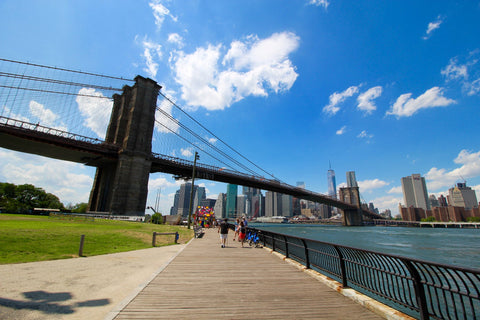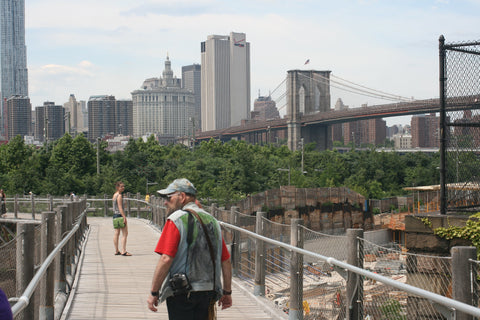Unless you’re a true Manhattanite hustling down Broadway from one engagement to the next (or a cabbie barreling down any NYC block), slow and steady DOES win the race. Case in point: Brooklyn Bridge Park. For more than a decade and counting, the Brooklyn waterfront has been braving an extensive, and at times excruciatingly painful, facelift — one that takes the concept of beautification to a whole new level. Bringing the area’s roots to the forefront, Brooklyn Bridge Park is a confluence of the past and an acknowledgment of a modern community’s needs.
Brooklyn Bridge Park sits on grounds once used exclusively as a wharf: Fulton Ferry Landing. There, in 1642, the first ferry service between Brooklyn and Manhattan launched, paving the way for a booming shipping industry. Businesses of all types — slaughterhouses, breweries, inns and taverns — eventually opened shop, and the village was incorporated as the town of Breuckelen. For centuries, the area thrived, until 1883 when momentum halted: After 13 years, construction of the iconic Brooklyn Bridge finished, creating the first physical link between Brooklyn and Manhattan. This was, of course, a groundbreaking development for its time, but the ferry boats unfortunately didn’t see much light at the end of the proverbial tunnel.
Like all disruptive innovations, the construction of the Brooklyn Bridge eliminated much of the demand for Fulton Ferry Landing’s shipping services. The tipping point of its functional demise came in the 1950s when the Brooklyn-Queens Expressway (BQE) was constructed. Elevated above and away from the waterfront, the BQE virtually separated Fulton Ferry Landing from Brooklyn Heights and its surrounding neighborhoods (an unfortunate practice with parallels in Newburgh and Buffalo). Warehouses stood isolated on Piers 1-6, paling in comparison to the skyscrapers and hustle of Wall Street across the East River and the hum of residential activity behind them in Brooklyn Heights. Adding insult to injury, in 1983, the Port Authority of New York put an end to cargo shipping operations there. Lacking demand and the right resources, the area was all but defunct.

Fast forward nearly twenty years and the former Fulton Ferry Landing is ripe with activity, and more parkland. Stretching north from the mouth of Atlantic Avenue up to Jay Street, the Park is a haven of 85 acres, including six refurbished jetties: Piers 1, 5 and 6 are open, 2 is under construction, and 3 and 4 are in a “future planning” phase (i.e. in the works but in need of funding). Green space and pedestrian walkways? Brooklyn Bridge Park has those in spades: Emerald lawns and turf sports fields provide respite from the concrete jungle while 1.3 miles of meandering paths welcome walkers, runners and bikers alike. Access to water? Well, that’s inevitable. The shorelines of Brooklyn Bridge Park offer expansive views of New York Harbor, including Manhattan and its many surrounding Islands, from Governor’s to Staten to Liberty, where the Statue waves to all Park visitors. (You can even spot the Verrazano Bridge and Jersey City.) Up next? Construction of Pier 2 is expected to be completed in Fall 2013, and will boast five acres of hardtop courts for basketball, handball and bocce — there will even be an in-line skating arena, restrooms and a snack stand.
The landscape architects behind this beast of a project infused the Park with ample opportunities to interact with the new amenities, encouraging visitors to slow. it. down. The project team at Michael Van Valkenburgh Associates considered every last detail when planning and implementing the design of Brooklyn Bridge Park, especially in regards to future generations of visitors. Sustainability played a major role in the Park’s construction, and to give you an idea of its scope: A rainwater irrigation system beneath Pier 1 captures up to 104,000 gallons of storm runoff to nurture a variety of plants (if last summer’s buds were any indication — orange daylilies, salt spray roses, black eyed susans and pickerelweed — this year’s will flourish); Longleaf Yellow Pine reclaimed from the area’s former warehouses can now be found in the various benches throughout the Park; the hilly topography is made of 40,000 cubic yards of clean material taken from the MTA’s Long Island Railroad East Side Access project (which will connect the LIRR to Grand Central); and the Park’s maintenance crews use solar-powered vehicles to investigate the grounds.
The icing on the cake? Ferries have returned! From Pier 1, you can explore NYC’s waterways, to the South Street Seaport and up the Hudson River by way of the Hop-On/Hop-Off NY Water Taxi, or cruise along the East River to Midtown Manhattan on the East River Ferry. For an afternoon of car-free R&R, head to Pier 6 to catch the Governor’s Island Ferry, a free ride that takes fewer than 10 minutes. What’s more, a boat launch off Pier 1 sends visitors to the sea in non-motorized skiffs, and free kayaking sessions are offered by the Brooklyn Bridge Boathouse.
For land-lovers, there is plenty to enjoy as well. The two lawns at Pier 1, so named Bridge View and Harbor View, are deliberately elevated to provide multiple vistas and shield the whirr of traffic from the BQE. Moving south toward Pier 5, the crunch of gravel laden paths below your feet adds just enough friction to slow your pace as you head to one of NYSOM’s favorite new spots: Picnic Peninsula, where communal grills are peppered among sturdy, salvaged-wood tables. They are available on a first-come, first-serve basis and we anticipate a packed peninsula each weekend this summer. NYSOM Tip: Bring a grill brush in case the BBQ-ers ahead of you don’t clean up after themselves.
Another favorite feature — and perhaps the most exciting — is the Squibb Bridge. This new suspension pathway for pedestrians finally (finally!) links the waterfront to Brooklyn Heights, undoing the 60+ year old interruption caused by that BQE divide. Vital to both areas, the connection leads visitors from Pier 1 over Furman Street to Squibb Park — a mere one minute walk from the Brooklyn Heights Promenade. Don't be alarmed if the bridge starts oscillating under your feet: Because it's a suspension bridge, the Squibb bounces up and down with every step — but don’t worry, it’s more delightful than scary.
We are excited to see what else crops up this summer and in the months ahead. For now, it goes without saying that the shorelines abutting the Brooklyn and Manhattan Bridges are once again thriving with life — and then some. After decades of inactivity, Brooklyn Bridge Park brings past, present and future together in a reinvigoration of history, creating a community mirroring that of Brooklyn’s earliest days. We are not only encouraged to engage with the area, but moreover are enticed by all that the land and water now has to offer. So, as the Welcome to Brooklyn sign reads on the westbound BQE, we at NYSOM want you to “Believe the Hype” surrounding Brooklyn Bridge Park. We certainly do.
Getting There
It couldn’t be easier to visit Brooklyn Bridge Park thanks to its many connections to roadways, subways and waterways. So, whether you’re on foot, in a car, taking public transportation or setting sail, you can find yourself here in less than an hour of your departure. Just don’t be surprised if you end up staying much longer than that.
A schedule of activities and events can be found HERE.


Leave a comment